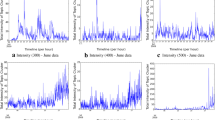Abstract
We propose a method of detecting the period in which a burst of information diffusion took place from an observed diffusion sequence data over a social network and report the results obtained by applying it to the real Twitter data. We assume a generic information diffusion model in which time delay associated with the diffusion follows the exponential distribution and the burst is directly reflected to the changes in the time delay parameter of the distribution. The shape of the parameter’s change is approximated by a step function and the problem of detecting the change points and finding the values of the parameter is formulated as an optimization problem of maximizing the likelihood of generating the observed diffusion sequence. Time complexity of the search is almost proportional to the number of observed data points and has been shown to be very efficient. We first demonstrated that the proposed method can detect the burst using a synthetic data and showed that it performs better than one of the representative state-of-the-art methods, confirming that the proposed method covers a wider range of change patterns. Then, we extended our evaluation on synthetic data to show that it is efficient and effective comparing it with a naive exhaustive search and a simple greedy method. We then apply the method to the real Twitter data of the 2011 To-hoku earthquake and tsunami, and reconfirmed its efficiency and effectiveness. Two interesting discoveries are that a burst period detected by the proposed method tends to contain massive homogeneous tweets on a specific topic even if the observed diffusion sequence consists of heterogeneous tweets on various topics, and that assuming the information diffusion path to be a line shape tree can give a good approximation of the maximum likelihood estimator when the actual diffusion path is not known.



















Similar content being viewed by others
Notes
Observed sequence \({\cal C}\) does not tell which parent activated which child. Without this assumption, we have to introduce hidden variables.
NHK is the government operated broadcaster.
Great Hanshin-Awaji Earthquake occurred on January 17, 1995 in Kobe area and 6,434 people lost their lives.
References
Akaike, H. (1974). A new look at the statistical model identification. IEEE Transactions on Automatic Control, 19, 716–723.
Araujo, L., Cuesta, J.A., Merelo, J.J. (2006). Genetic algorithm for burst detection and activity tracking in event streams. In Proceedings of the 9th international conference on Parallel Problem Solving from Nature (PPSN’06) (pp. 302–311).
Bonacichi, P. (1987). Power and centrality: a family of measures. American Journal of Sociology, 92, 1170–1182.
Ebina, R., Nakamura, K., Oyanagi, S. (2011). A real-time burst detection method. In Proceedings of the 23rd IEEE International Conference on Tools with Artificial Intelligence (ICTAI) (pp. 1040–1046).
Goldenberg, J., Libai, B., Muller, E. (2001). Talk of the network: a complex systems look at the underlying process of word-of-mouth. Marketing Letters, 12, 211–223.
Katz, L. (1953). A new status index derived from sociometric analysis. Sociometry, 18, 39–43.
Kempe, D., Kleinberg, J., Tardos, E. (2003). Maximizing the spread of influence through a social network. In Proceedings of the 9th ACM SIGKDD international conference on knowledge discovery and data mining (KDD-2003) (pp. 137–146).
Kimura, M., Saito, K., Nakano, R., Motoda, H. (2010). Extracting influential nodes on a social network for information diffusion. Data Mining and Knowledge Discovery, 20, 70–97.
Kleinberg, J. (2002). Bursty and hierarchical structure in streams. In: Proceedings of the 8th ACM SIGKDD international conference on knowledge discovery and data mining (KDD-2002) (pp. 91–101).
Rissanen, J. (1989). Stochastic complexity in statistical inquiry. World Scientific.
Sadikov, E., Medina, M., Leskovec, J., Garcia-Molina, H. (2011). Correcting for missing data in information cascades. In Proceedings of the 4th ACM international conference on Web Search and Data Mining (WSDM 2011) (pp. 55–64).
Saito, K., Kimura, M., Ohara, K., Motoda, H. (2009). Learning continuous-time information diffusion model for social behavioral data analysis. In Proceedings of the 1st Asian Conference on Machine Learning (ACML2009), LNAI (Vol. 5828, pp. 322–337).
Saito, K., Kimura, M., Ohara, K., Motoda, H. (2010). Selecting information diffusion models over social networks for behavioral analysis. In Proceedings of the 2010 European Conference on Machine Learning and Principles and Practice of Knowledge Discovery in Databases (ECML PKDD 2010), LNAI (Vol. 6323, pp. 180–195).
Sun, A., Zeng, D., Chen, H. (2010). Burst detection from multiple data streams: a network-based approach. IEEE Transactions on Systems, Man, & Cybernetics Society, Part C, 40, 258–267.
Wasserman, S., & Faust, K. (1994). Social network analysis. Cambridge, UK: Cambridge University Press.
Watts, D.J. (2002). A simple model of global cascades on random networks. Proceedings of National Academy of Science USA, 99, 5766–5771.
Watts, D.J., & Dodds, P.S. (2007). Influence, networks, and public opinion formation. Journal of Consumer Research, 34, 441–458.
Zhang, X. (2006). Fast algorithms for burst detection. PhD dissertation, New York University. http://pdf.aminer.org/000/301/507/better_burst_detection.pdf.
Zhu, Y., & Shasha, D. (2003). Efficient elastic burst detection in data streams. In Proceedings of the 9th ACM SIGKDD international conference on knowledge discovery and data mining (KDD-2003) (pp. 336–345).
Author information
Authors and Affiliations
Corresponding author
Additional information
The Twitter data we used in this paper were provided by Prof. Fujio Toriumi of Tokyo University and Prof. Kazuhiro Kazama of Wakayama University. This work was partly supported by Asian Office of Aerospace Research and Development, Air Force Office of Scientific Research under Grant No. AOARD-13-4042, and JSPS Grant-in-Aid for Scientific Research (C) (No. 23500194).
Rights and permissions
About this article
Cite this article
Saito, K., Ohara, K., Kimura, M. et al. Change point detection for burst analysis from an observed information diffusion sequence of tweets. J Intell Inf Syst 44, 243–269 (2015). https://doi.org/10.1007/s10844-013-0283-2
Received:
Revised:
Accepted:
Published:
Issue Date:
DOI: https://doi.org/10.1007/s10844-013-0283-2




